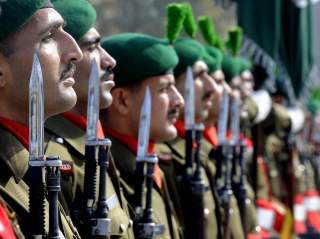As Pakistan’s Sharif Visits, Washington Should Leverage Gains in Pakistan
Pakistan is finally getting its act together in many critical ways.
The claim of some that the Pakistan Army desires a state of permanent conflict with India has little basis in reality. In 2007, during the last period of military rule, India and Pakistan were close to a comprehensive deal on Kashmir. Domestic instability in Pakistan, the Mumbai attacks, and a hardened approach in India derailed that process. But it could be easily revived. The dividends of a final resolution to the conflict in Kashmir will include a dramatic reduction in the likelihood of nuclear conflict in South Asia.
Obama and Sharif may also discuss the future of U.S. aid to Pakistan. The Pakistan Army has stated that it will remain in the tribal areas along the Afghanistan border into 2019. A continuation of the Coalition Support Funds, which reimburse Pakistan for support it provides in the war on terror, into 2019 is imperative for stability in the region, especially as the Afghan National Army faces high casualty and attrition rates.
In 2008, Congress passed the Kerry-Lugar-Berman Act, which pledged $7.5 billion in aid to Pakistan over the course of five years. Only 60% of that money has been spent. Washington and Islamabad should figure out how to spend the remaining 40%. The United States has focused on addressing Pakistan’s energy shortages. But it might want to consider appropriating the funds for projects that fill gaping holes in Pakistan’s public education system—such as support for a municipal library system in Karachi.
But more important for Pakistan than aid is trade. The Trans-Pacific Partnership agreement may offer a deadly blow to Pakistan’s once-dominant, but now fledgling, textile industry. Pakistan’s industry has been unable to compete with Bangladesh, which has seized market share due to a combination of low wages, energy subsidies, and preferential treatment in the West. It will lose more business to TPP members like Vietnam. Islamabad and Washington ought to consider ways to increase U.S. market access for Pakistani textiles and other exports with strong potential, including furniture.
Finally, the US can try to adapt Pakistan’s strategic culture by integrating the country into global rule-making institutions and multilateral organizations. Pakistanis take pride in being a top contributor of U.N. peacekeeping forces and a key player in combating piracy in the Indian Ocean region through the Combined Task Force 151.
Admitting Pakistan into the Nuclear Suppliers Group, after taking measures to enhance the global nonproliferation regime, may be another way to help transition Islamabad into being a more constructive player in the global system. But, as discussed earlier, such a proposal may be dead on arrival if the issue of Pakistan’s tactical nuclear capability is delinked from the long-standing but resolvable issues that form the basis of the India-Pakistan conflict.
Climate change might be another global issue on which Pakistan can be impactful. Hammered by record floods in 2010 and an unprecedented heat wave this summer, Pakistan is the canary in the coal mine when it comes to climate change. But it is also a poor country dependent on cheap sources of fuel, including coal. There is ample incentive for both Washington and Islamabad to find ways to incentivize a comprehensive approach toward combating climate change, without damaging economic growth.
From the World’s Most Dangerous Country to an Island of Stability?
Pakistan is getting its act together as the Muslim world appears to be descending deeper into authoritarianism and civil violence.
Iraq and the Levant have been torn asunder by IS, Shia militias, and sectarian governments. A false sense of stability exists in Egypt, where democracy died a quick death, and Mubarakism is alive and well in the form of President Abdel Fattah el-Sisi. The Taliban spread deeper into Afghanistan, even while U.S. forces are present in the country. In Bangladesh, the secular Awami League is pushing the country toward becoming a one-party state, prosecuting and imprisoning much of the opposition.
While Pakistan has suffered immensely in the past decade from terrorism, misgovernance and poor economic growth, it may end up being an oasis of calm in an increasingly unstable part of the world. But as Pakistan shelters itself from the storm of hitting the Middle East and South Asia today, a tighter embrace between Islamabad and Washington becomes even more necessary.
Arif Rafiq (@arifcrafiq) is president of Vizier Consulting, LLC, which provides strategic guidance on Middle East and South Asian political and security issues.
Image: Wikimedia Commons/U.S. Air Force

